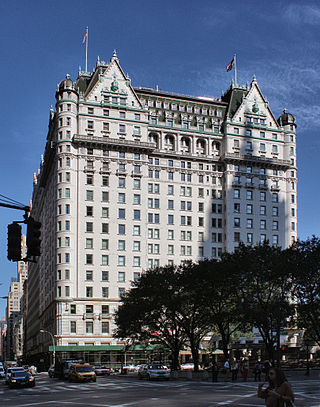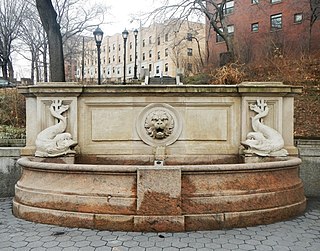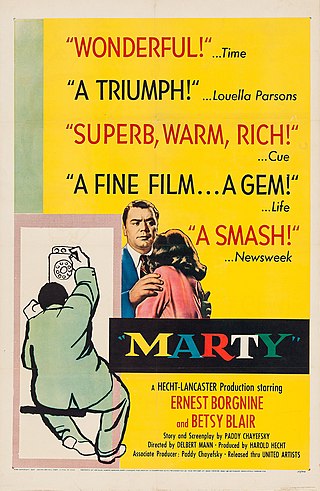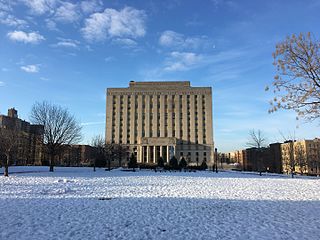Related Research Articles

The Plaza Hotel is a luxury hotel and condominium apartment building in Midtown Manhattan in New York City. It is located on the western side of Grand Army Plaza, after which it is named, just west of Fifth Avenue, and is between 58th Street and Central Park South, at the southeastern corner of Central Park. Its primary address is 768 Fifth Avenue, though the residential entrance is One Central Park South. Since 2018, the hotel has been owned by the Qatari firm Katara Hospitality.

Highbridge is a residential neighborhood geographically located in the central-west section of the Bronx, New York City. Its boundaries, starting from the north and moving clockwise, are the Cross-Bronx Expressway to the north, Jerome Avenue to the east, Macombs Dam Bridge to the south, and the Harlem River to the west. Ogden Avenue is the primary thoroughfare through Highbridge.
The Concourse Line is an IND rapid transit line of the New York City Subway system. It runs from 205th Street in Norwood, Bronx, primarily under the Grand Concourse, to 145th Street in Harlem, Manhattan. It is the only B Division line in the Bronx, and also the only line in the Bronx with all stations underground.

Hyatt Regency Albuquerque is a 20-story high-rise hotel located at 330 Tijeras Avenue NW in downtown Albuquerque, New Mexico. The building is 78 m (256 ft) tall, making it Albuquerque's second tallest building and tallest hotel. It was built in 1990 as part of the Albuquerque Plaza mixed-use complex on the south side of Civic Plaza, which also includes the Albuquerque Plaza tower.

The Grand Concourse is a 5.2-mile-long (8.4 km) thoroughfare in the borough of the Bronx in New York City. Grand Concourse runs through several neighborhoods, including Bedford Park, Concourse, Highbridge, Fordham, Mott Haven, Norwood and Tremont. For most of its length, the Concourse is 180 feet (55 m) wide, though portions of the Concourse are narrower.

The Windsor Hotel was a hotel located in Montreal, Quebec, Canada. It is often considered to be the first grand hotel in Canada, and for decades billed itself as "the best in all the Dominion".

Hotel Astor was a hotel on Times Square in the Midtown Manhattan neighborhood of New York City, United States. Built in 1905 and expanded in 1909–1910 for the Astor family, the hotel occupied a site bounded by Broadway, Shubert Alley, and 44th and 45th Streets. Architects Clinton & Russell designed the hotel as an 11-story Beaux-Arts edifice with a mansard roof. It contained 1,000 guest rooms, with two more levels underground for its extensive "backstage" functions, such as the wine cellar.

Macombs Dam Park is a park in the Concourse section of the Bronx, New York City. The park lay in the shadow of the old Yankee Stadium when it stood, between Jerome Avenue and the Major Deegan Expressway, near the Harlem River and the Macombs Dam Bridge. The park is administered and maintained by the New York City Department of Parks and Recreation. The majority of Macombs Dam Park was not open to the public from August 2006, when construction began on the new Yankee Stadium, to April 2012.

The 161st Street–Yankee Stadium station is a New York City Subway station complex shared by the elevated IRT Jerome Avenue Line and the underground IND Concourse Line. It is located at the intersection of 161st Street and River Avenue in the Highbridge and Concourse neighborhoods of the Bronx. It is generally served by the 4 train at all times; the D train at all times except rush hours in the peak direction ; and the B train during rush hours.

The Nassau Inn is a full-service hotel in downtown Princeton, New Jersey, United States. It first opened at 52 Nassau Street in 1769 in a home built in 1756. The Inn experienced British occupation during the American Revolution and played host to members of the Continental Congress when it met in nearby Nassau Hall. In 1937, the original inn was demolished to make way for the Palmer Square development and a new, larger, inn opened at 10 Palmer Square in 1938. The hotel's restaurant, the Yankee Doodle Tap Room, has a large mural by Norman Rockwell, depicting Yankee Doodle, behind the bar. It is within walking distance of Princeton University.
The West Bronx is a region in the New York City borough of the Bronx. The region lies west of the Bronx River and roughly corresponds to the western half of the borough.

Marty is a 1955 American romantic drama film directed by Delbert Mann in his directorial debut. The screenplay was written by Paddy Chayefsky, expanding upon his 1953 teleplay of the same name, which was broadcast on The Philco-Goodyear Television Playhouse and starred Rod Steiger in the title role.

Jerome Avenue is one of the longest thoroughfares in the New York City borough of the Bronx, New York, United States. The road is 5.6 miles (9.0 km) long and stretches from Concourse to Woodlawn. Both of these termini are with the Major Deegan Expressway which runs parallel to the west. Most of the elevated IRT Jerome Avenue Line runs along Jerome Avenue. The Cross Bronx Expressway interchanges with Jerome and the Deegan. Though it runs through what is now the West Bronx neighborhood, Jerome Avenue is the dividing avenue between nominal and some named "West" and "East" streets in the Bronx; Fifth Avenue, and to a lesser extent, Broadway, also splits Manhattan into nominal "West" and "East" streets.

161st Street is a short, major thoroughfare in the southern portion of the Bronx. The road is 1.6 miles (2.6 km) long and is a much used access to Yankee Stadium on its north side. The 20th-century Yankee Stadium was on the south side of the street. The road begins in the west at an intersection with Jerome Avenue, a major thoroughfare in the Bronx, and Woodycrest Avenue, a one-way street in the Bronx. The road is one of the widest in the Bronx, until the Sheridan Avenue intersection, where the divided highway merges. East 161st Street ends at Elton Avenue. However, the road continues eastward in parts, ending at Hewitt Place, as a short connector.

The Bronx County Hall of Justice is an American courthouse at 265 East 161st Street, between Sherman and Morris Avenues in the Concourse and Melrose sections of the Bronx in New York City, New York. The ten-story building has 775,000 square feet (72,000 m2) and includes 47 New York Supreme Court and New York City Criminal Court rooms, seven grand jury rooms, and office space for the New York City Department of Correction, New York City Department of Probation, and the district attorney.

Bronx Terminal Market, formerly known as Gateway Center at Bronx Terminal Market, is a shopping mall along the Major Deegan Expressway in Concourse, Bronx, New York. The center encompasses just under one million square feet of retail space built on a 17-acre (69,000 m2) site that formerly held a wholesale fruit and vegetable market as well as the former Bronx House of Detention for Men, south of Yankee Stadium.

Grand Hyatt Mumbai is a luxury five star hotel located off the Western Express Highway, Santacruz (East) in Mumbai, India. Designed by Chicago's Lohan Associates, Grand Hyatt Mumbai was opened in 2004.

The Lorelei Fountain, also known as the Heinrich Heine Memorial, is a monument located on East 161st Street in the Concourse section of the Bronx, New York City, near the Bronx County Courthouse. It was designed by German sculptor Ernst Herter and created in 1896 out of Italian white marble in Laas, South Tyrol. The fountain was unveiled at its current location in 1899 and is dedicated to German poet and writer Heinrich Heine.

Concourse is a neighborhood in the southwestern section of the New York City borough of the Bronx which includes the Bronx County Courthouse, the Bronx Museum of the Arts, and Yankee Stadium. Its boundaries, starting from the north and moving clockwise, are East 169th Street to the north, Webster Avenue to the east, East 149th Street to the south, and Jerome Avenue and Harlem River to the west. The neighborhood is divided into three subsections: West Concourse, East Concourse, and Concourse Village with the Grand Concourse being its main thoroughfare.
References
- ↑ Frederick M. Binder, David M. Reimers (1996). All the Nations Under Heaven: An Ethnic and Racial History of New York City . Columbia University Press. pp. 153–154. ISBN 0-231-07879-X.
concourse plaza hotel.
- 1 2 Anthony Connors (May 24, 1998). "Then & Now: The Bronx' Grand Hotel". New York Daily News. Retrieved May 26, 2009.[ permanent dead link ]
- ↑ "Frank Gifford: The game that changed football". Today.com. November 10, 2008. Retrieved May 26, 2009.
- 1 2 Jill Jonnes (2002). South Bronx Rising: The Rise, Fall, and Resurrection of an American City. Fordham University Press. pp. 130, 281. ISBN 0-8232-2199-7.
- ↑ Ray Carney. "Chapter on The Making of Gloria (1979-1980)". Ray Carney’s Cassavetes on Cassavetes Book. Retrieved May 26, 2009.